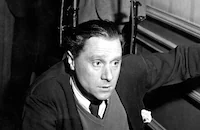The True Glory
Cast & Crew
Carol Reed
Robert Harris
William Alwyn
Harry Brown
Bob Carrick
Bob Clarke
Film Details
Technical Specs

Synopsis
Following a brief history of Adolf Hitler's military expansion in Europe, this documentary outlines the Allied plan to smash his forces. While American military commanders plan a European invasion at Normandy, American workers are seen building ships and transporting war materiel. The film relates personal stories told by civilians and soldiers about the war effort, and shows enlistees performing their training exercises. After General Dwight David Eisenhower is seen coordinating the master plan for the attack with Allied military leaders, scenes from the actual landing at Normandy are shown. Daybreak after the invasion brings with it unsettling pictures of injured and dead soldiers on Omaha Beach. Some of the soldiers being treated for wounds discuss their daily military routines and complain of battle weariness. An improvised harbor facility known as "Operation Mulberry" facilitates the advance of Allied troops through the hedgerows outside Cherbourg. On 25 June 1944, the French city of Cherbourg is captured by the Allied forces, which march on to Caen and Saint-Lô. Scenes of celebration as the Allied troops march into small towns and cities are pictured, as are scenes showing the capture of prisoners by the Allies. In Paris, a description of life under German occupation is followed by a commentary on the resistance effort. The arrival of General Charles De Gaulle and the Free French troops in Paris is shown. Soldiers relate their experiences fighting through the Low Countries into Germany. The Yalta meeting between President Franklin D. Roosevelt, British Prime Minister Winston Churchill and Soviet leader Joseph Stalin is depicted. Troops cross the Rhine over a bridge at Remagen. U.S. prisoners are liberated and react to the news that Roosevelt has died. When Allied troops enter the Bergen Belsen concentration camp, pictures of the atrocities committed inside are made available to the entire world. All of Germany is eventually occupied by the Allied forces, and at midnight on 9 May 1945, the gunfire stops.

Crew
William Alwyn
Harry Brown
Bob Carrick
Bob Clarke
Jerry Cowan
D. P. Fields
Roger Furse Royal Navy
G. Gardiner
Frank Harvey
Patrick M. Jenkins
Gerald Kersh
Saul Levitt
Arthur Macrae
Eric Maschwitz
Muir Mathieson
Jenny Nicholson
Guy Trosper
Peter Ustinov
Robert Verrell

Film Details
Technical Specs

Quotes
Trivia
Notes
The film's title card reads: "The Governments of Great Britain and the United States of America present The True Glory." According to the New York Times review, this film was "conceived by Gen. Dwight D. Eisenhower as the full film record of the European war." Although all contemporary reviews mention a spoken introduction by Eisenhower, the viewed print and the print in NARS do not include this introduction. According to the Time review, of the 1,400 cameramen who shot footage for the film, thirty-two were killed, sixteen were declared missing and 101 were wounded. The film ends with these lines from the prayer offered by Sir Francis Drake before he went out to fight the Spanish Armada: "O Lord God, who now givest to Thy servants to endeavor in a great matter. Grant to us also to know that it is not the beginning but the continuing of the same until it is thoroughly finished which yieldeth the true glory." The film won an Academy Award for Best Feature Documentary.














